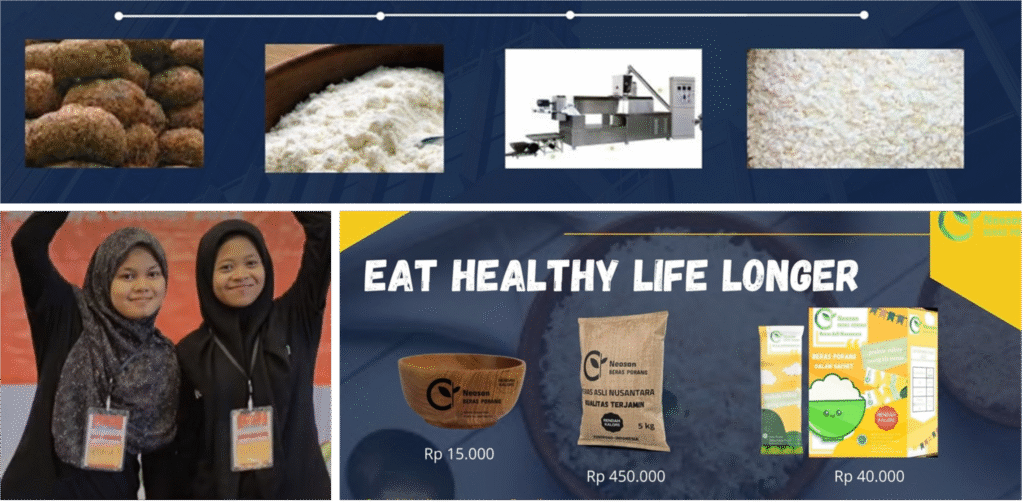
The Problem and Motivation Behind
Laili Faizati (23-year-old) and her teammate grew up in a rural community where white rice is a staple food, despite its negative effects on increasing blood sugar levels. They found out that Indonesia ranks among the countries with the highest number of adults living with diabetes, posing a significant health challenge for many Indonesians. At the same time, the country relies heavily on imported white rice, making it vulnerable to global price fluctuations and food insecurity.
Additionally, Laili and her teammate witnessed firsthand how local farmers in their community were struggling economically, despite growing a valuable crop called porang tubers. These tubers look like round, knobby potatoes. They found out that porang tubers can be processed into a healthier alternative to white rice, which does not raise blood sugar levels. However, many farmers are unaware of this potential and continue to sell their harvests raw at low prices, missing out on the benefits of value-added processing. “Farmers sell their porang tubers cheaply to big companies. We wanted to add value to their produce and help them earn more,” says Laili.
The Innovative Solution
“We wanted to create a solution that helps people eat healthier while also supporting our farmers. Porang Rice can be that change… If we produce more Porang Rice, we can reduce our country’s reliance on imported rice and support our own farmers,”” — Laili Faizati
When Lili and her teammate joint the Youth Innovation Lab (YIL), they seize the opportunity that Porang tubers offer to find a sustainable and healthier alternative to traditional rice. Their goal was to produce Porang Rice thathas several health and economic benefits:
- Low in sugar and glycaemic index: A great alternative for diabetics and health-conscious consumers.
- High in fibre: Aids digestion, controls appetite, and lowers cholesterol.
- Economic value: By adding value to porang tubers, farmers can significantly increase their income.
- Locally sourced and sustainable: Reduces Indonesia’s dependence on imported rice.
Through a designing thinking process, they gathered information about different techniques and machines used in producing Porang Rice. Then they designed a prototype of the production process that involves key steps, as follows:
- Chopping: The porang tubers are chopped into small pieces.
- Drying: The chopped pieces are dried to reduce moisture.
- Grinding: The dried pieces are ground into flour.
- Shaping: An extractor machine forms the flour into rice-shaped grains.
Community members have shown increasing interest in porang rice as they learn more about its health benefits. The project is currently in the planning phase, with efforts focused on testing the market and ensuring product quality.
Moreover, Lili and her teammate received training from the Youth Innovation Lab (YIL), that enabled them to gain business skills, including planning, branding, and managing their project. The YIL also provided mentorship that helped them understand how to highlight the product’s strengths, assess market competition, and apply sustainable business principles. “The Innovation Lab helped us plan our business better, including identifying the issues and highlighting our product’s strengths. We also learned about the importance of green businesses in today’s world.” — Laili shares.
Lessons Learned from Addressing Challenges
- Ensuring safe processing: One major challenge was that porang tubers contain toxins if not processed properly. The team focused on thorough research and training to develop safe and reliable processing methods. Laili explains “Our biggest challenge is the process of turning porang tubers into rice. If we do not process it correctly, it can lead to food poisoning. We have to make sure our products are safe.”
- Seeking investors to financial barriers: The machinery required for transforming porang into rice is expensive, making mass production difficult. To address this, Laili’s team actively seeks investors to secure the necessary equipment.
- Building consumer awareness: Porang rice is still relatively unknown, requiring substantial marketing efforts to educate potential customers about its benefits. To tackle this, Laili and her team conducted market trials and developed pricing strategies to make the product more accessible.
Next Steps and Future Aspirations
“We hope Porang rice will become as common as white rice—offering a healthier choice for every household,” Laili concludes.
Laili envisions scaling up porang rice production to make it widely available across Indonesia. The future plans include:
- Starting Production: Increasing processing capacity to make porang rice more widely available.
- Empowering Farmers: Building partnerships with porang farmers to enhance their income.
- Market Launch: Introducing porang rice to supermarkets, local stores, and online platforms.
- Health Awareness Campaigns: Educating the public on the benefits of porang rice to build consumer trust and demand.